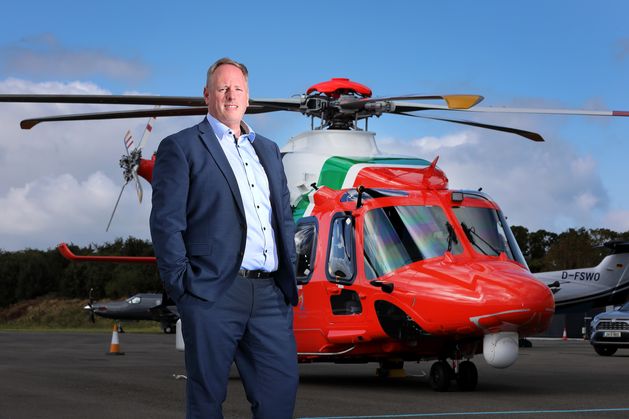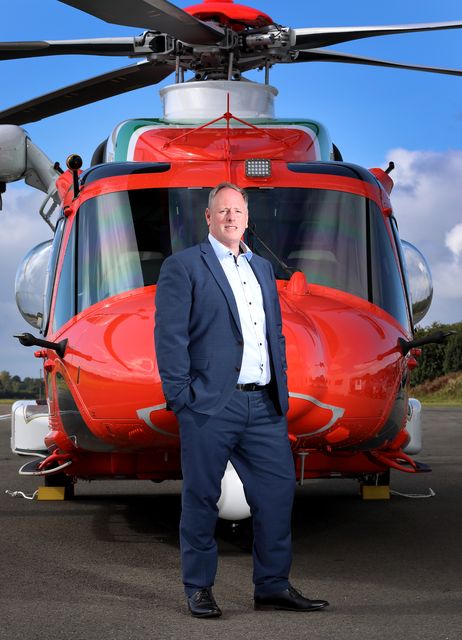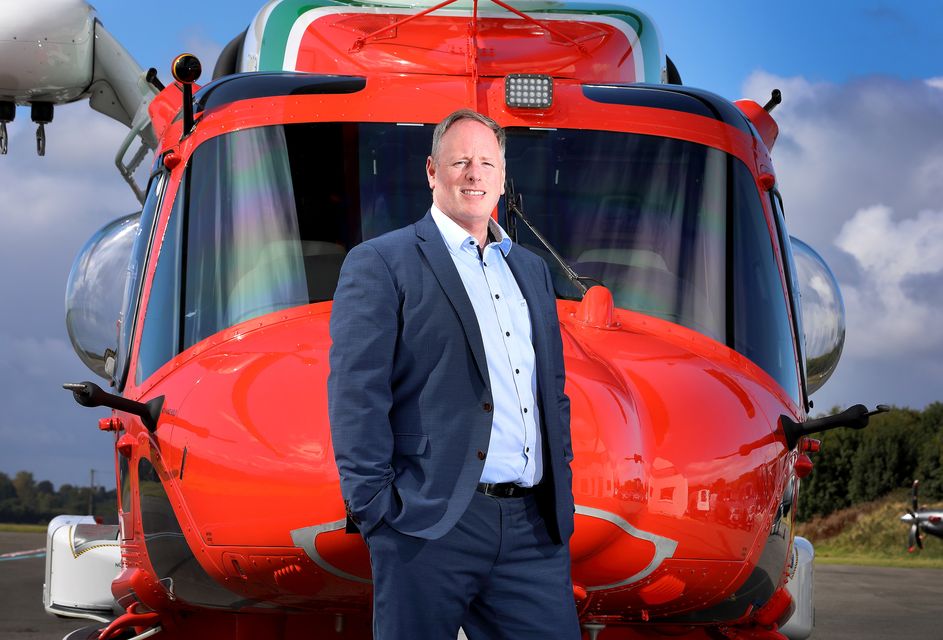Philip Bartlett of Bristow Ireland is the chief of Ireland’s rescue helicopter service
He points up to a sign reading Bristow Ireland – the firm that has won the tender to supply Ireland’s Coast Guard helicopter search and rescue services – hanging on the front wall.
“We just got it hung 20 minutes ago,” he says, relieved to have one more item crossed off a long list.
‘It is a business – and we provide a search-and-rescue service to the highest standards’
Inside the building, new computers have been switched on, office furniture has been assembled and someone has just figured out how to work the complicated new office coffee machine.
Bartlett and his operational and engineering staff are currently working flat out to obtain an array of stringent regulatory approvals and airworthiness certifications from the Irish Aviation Authority (IAA) that will allow the operation to get off the ground and begin training flights.
“This is years in the making,” says Bartlett. “The work and effort that has gone into this has been incredible.”
Bartlett himself only took the top job at Bristow Ireland in March after a 30-year-plus career elsewhere in Irish aviation. He will lead the firm as it takes over the contract from CHC Ireland in a staged transition between now and next June.
“The team have been in project mode for a long period of time, and now we’re in a key transition, moving into a stage where we’re starting to operate. It’s quite satisfying to see that happening.
“It’s going to be a steady increase from now up to an operational tempo. We have a lot of flying to do between now and then – to bed-in maintenance, flight operations, crew training, ground ops and security.”
The overall contract is worth €800m over 10 years to the Houston, Texas-headquartered helicopter-focused aviation firm.
It has a €100m financing facility to purchase six helicopters to operate the service from Shannon, Waterford, Sligo and Weston – a new base that will replace Dublin Airport as home for the Coast Guard’s Rescue 116 helicopter.
Philip Bartlett with one of the new AW189 helicopters at Weston. Photo: Frank McGrath
The big red and grey helicopters – like garda cars, fire engines or Defence Forces vehicles – are very visible manifestations of the State’s role in protecting its citizens.
Bartlett sees no tension between this and the fact that the 24/7 service is to be operated by a business that is listed on the New York Stock Exchange.
“I am accountable to Bristow and, yes, it is a business. But principally what we are providing is a search-and-rescue service to the highest standards – and we’re accountable in terms of performance to the Department of Transport.
“We are tasked by the Coast Guard and its Marine Rescue Centres for our missions and fulfilling those missions is our only objective.“
Search and rescue (SAR) was delegated to the Irish Air Corps until 2004, after which it was outsourced to the private sector. Bristow previously bid for the tender but lost out to current incumbent CHC, which has operated the service for the past 13 years.
This time, Bristow – which has a large oil and gas platform servicing business, as well as running search and rescue operations in the UK, the Netherlands and the Falkland Islands – won out.
‘We see this as very much a clean sheet opportunity to build and develop’
“We are in 18 countries across six continents with 220 helicopters. There’s massive experience behind us,” he says.
As part of the contract, Bristow will operate six new AW189 helicopters to replace the CHC’s current fleet of S92 helicopters. Both models are go-to aircraft for search and rescue operations around the world – but the newer AW189 comes with a new generation of avionics equipment.
“It’s an extremely capable helicopter,” says Bartlett.
The service will now also benefit from the provision of two fixed-wing aircraft which will provide “top cover” for the helicopters and are also capable of search and rescue in their own right.
“Those aircraft will be able to drop life rafts and emergency equipment. They can also be used for pollution control and as air ambulances.”
The Shannon base will transfer to Bristow from CHC on October 31 with Sligo and Waterford to follow. Finally, next June, CHC’s base at Dublin Airport will close and Bristow’s new Weston operation will take over rescue services on the east coast.
Bristow has just been given regulatory approval to carry out its maintenance operations on the AW189s.
“Gaining approvals from the IAA is a difficult process. They are extremely rigorous. We hope next week to get our approval to start training within Ireland with the helicopter.”
CHC’s crews are to transfer to Bristow, bringing with them vital knowledge and expertise.
Philip Bartlett. Photo: Frank McGrath
But it has not been an entirely smooth process. CHC has taken a legal case against Bristow, claiming it wanted to provide “certainty and clarity” for its staff as Bristow prepares to take over the search-and-rescue service.
Bartlett declines to comment on ongoing legal proceedings.
“What I can say is that Bristow is very mindful that we are taking on the incumbent staff – and, personally, I’m looking forward to that.
“We’ve had very positive engagement with the staff in a series of town halls. We’ve gone across all the bases. We’ve had a second session in Shannon, which allowed me, for the first time, to be able to communicate with all the staff. We’re going to follow up again in early September.”
The company also proactively engaged with the unions, he says.
“We see this as very much a clean-sheet opportunity to build and develop. We have framework agreements in place with Unite, who represent the engineers, with Forsa, who represent the technical crew, and with IALPA, who represent the pilots.”
‘I always wanted to end up working with helicopters’
There’s been “very, very positive engagement and constructive dialogue” ahead of the first base transfer in October.
Pilots, engineers and technical crews have all sought information and clarifications but he is satisfied that there is “a pathway” to full agreement and that both sides are “fully committed and engaged”.
“The process is ongoing – and we fully anticipate, given that we are becoming operational in October, that everything is as on schedule as it can be.
” We are very cognisant of change, and some of the incumbent staff have been with them [CHC] for a long time. But we’ve been communicating very clearly with their representatives to ensure they understand our plan and how we’re going to deal with their integration.”
Perhaps the biggest change Bristow is implementing – aside from the introduction of new helicopters – is the move from Dublin Airport to Weston, where it has planning permission to build a bespoke base.
The private airfield, with its lines of Cessna trainers and visiting executive jets and helicopters, is now owned by a John Collison-led group of investors.
“Weston is a fantastic airport,” says Bartlett. “The building of the second runway at Dublin meant that the current [Coast Guard helicopter] facility is now located between the two runways. That causes additional operational complexity – both for the airport and for ourselves.
“Moving here takes that complexity out of the equation and it’s beneficial for everyone.
“It’s one thing when we are training, but as soon as we go into a mission and we use the call sign ‘Rescue’ then the priority is given to us – and that has an impact on the airport operation.”
The extra flying time from Weston to the coast, instead of from Dublin Airport, is minimal, he says.
“Any increased response time to the coast would be countered by quicker response times to overland taskings,” he points out.
Bartlett was not yet working for Bristow when the original decisions around its bid were being made – but he is delighted with the move to Weston. He declines to say whether Bristow got a better commercial deal at Weston than CHC had for its operation from DAA at Dublin Airport.
“I think it was quite visionary. Coming out here coincided with a change of management at Weston and there has been very positive engagement between us both.”
‘There’s a difference between commercial flying and search and rescue’
The Air Corps, whose main base at Baldonnel is just three miles from Weston, expressed safety concerns for its own aircraft when Bristow sought permission for the move. But Bartlett is confident that any issues can be ironed out.
The move to the airfield was flagged as part of the tender process from the beginning, he says.
“Operational issues and interoperability between ourselves and any of the other stakeholders in the neighbourhood are controlled under already existing standard operating procedures.
“There’s an existing framework – and the flight training school and active general aviation field that is here already works in good harmony with the surrounding airspace.”
The ins and outs and strict protocols of aviation procedures are nothing new to Bartlett. His new role is his dream job, he says.
“I didn’t sit down and plan how I was going to get here – but I always wanted to end up working with helicopters.”
His fascination began a long time ago. The eldest of three, he grew up in Deansgrange, near the National Rehabilitation Hospital.
“The Air Corps’ Alouette and Dauphin helicopters would fly over our house on their way to pick up or drop off patients. They had a very particular sound and you would hear them before you would see them.”
He would then jump onto his bike and race off to see them land at the hospital’s helicopter pad.
“They were fantastic machines and that’s all I ever wanted to do.”
‘Safety is everything to us. Everything we do comes with risk assessment’
Bartlett’s father was a self- taught engineer with a workshop at home where he made furniture and souvenirs for the US market.
“He’d make little jaunting carts with all the brass fittings and little lumps of turf. He could do anything with his hands.”
His father was also an amateur radio enthusiast. The house bristled with aerials and antennas and echoed with Morse code.
“The lads in the Signal Corps in Lebanon would be on HF [high frequency radio] and though he had no interest in sport, he’d read out the Sunday Independent sports pages every week to them – from start to finish.
“For years soldiers would call to the house and bring him back a souvenir. We had an artillery shell, a grenade, even a bit of an RPG rocket launcher.”
School had not sparked Bartlett’s imagination – and after the Leaving Cert, college seemed out of reach. He began working in a local supermarket. He dreamt of being an Air Corps pilot but the competition was fierce and he didn’t get the call.
But when Aer Lingus advertised an avionics apprenticeship scheme for young engineers he jumped at the chance. He loved it from day one, working on Boeing 737s while also studying electronics at DIT. He went from having zero academic interest to being top of his class in Kevin Street.
Aer Lingus was in some turmoil at the time with the Team Aer Lingus strike – but when that ended, the airline offered its engineers the chance to move to Shannon where it was basing a new fleet of Airbus A330 aircraft.
As part of his role he would travel to the Airbus factory in Toulouse, gaining invaluable experience that allowed him ultimately become a supervisor.
In 2013 he decided to move on from Aer Lingus and took a role in Shannon as a design engineer working for a company that modified aircraft for the major aircraft leasing companies.
Philip Bartlett at Weston Airport. Photo: Frank McGrath
He would later work with an operator of corporate jets and helicopters, before moving away from the hangars into an office, to become technical operations manager for an aircraft lessor.
“By then I was asking myself whether I wanted to be an engineer for the rest of my life.
“There is a well-trodden path from aircraft engineering into the leasing business. But it’s a whole different world. It’s very dynamic. You are moving aircraft globally between jurisdictions, and it definitely broadens your horizons.”
When he applied for and got the lead role at Bristow Ireland earlier this year, it was a dream come true.
After many years in the worlds of civil aviation and the leasing industry, the former Aer Lingus aircraft engineer believes he has moved into the very cutting edge of the aviation world in terms of the skill and professionalism that are involved.
Commercial crews are in the business of avoiding crisis. Search and rescue crews, on the other hand, are often tasked with flying directly into it.
“The people in commercial aviation are obviously hugely professional – but there’s a difference between commercial flying and search and rescue,” he says.
The tragic crash of Rescue 116 in 2017 starkly underlined the risky nature of the work that the search and rescue helicopter crews undertake. Bartlett is not inclined to comment in any detail on that crash, but recalls his own shock when he heard the news.
“It was an absolute tragedy. I think what it did do was highlight the risks that these folks take on a daily basis. As an organisation, we send out two pilots and two technical crew to save lives in an environment that carries a high risk.
“But safety is everything to us. Everything we do comes with risk assessment. Even moving into this office came with a risk assessment to identify hazards and mitigate risks. It’s front and centre the whole time in what we do – and it is vital that our procedures are robust.
“There’s a well-established framework around managing that risk. We identify the hazards, discuss the risks, then mitigate accordingly. That framework informs operational manuals and flight crews use this and their training to dynamically assess each situation.”
Bartlett expects to take part in some training exercises himself – including, if necessary, being plucked out of the sea by a crew. To take part in this he will need to undertake Helicopter Underwater Escape Training (HUET).
“From my perspective, given that the people here are doing this day-in day-out, it’s hugely important that I understand exactly what they are exposed to when I am talking to them.”
When he was an Aer Lingus engineer, he paid for and took 60 hours of private flying lessons for similar reasons. He dealt with pilots every day, so he wanted to better understand their job.
“It just gave me a very good oversight of their world and the link between that and what I was doing as an engineer.”
Undertaking some search and rescue training is also important in terms of his relationship with the team, he says.
“You have to see the reality of these things to understand them. It’s important that I fully understand and respect what they are doing – and, for me, to be able to put my faith in their hands is a huge thing.”
It is just one more task on a long checklist.
“No two days in aviation are the same,” he says. “For me, this is a whole new adventure.”
Curriculum Vitae
Name: Philip Bartlett
Title: Director Irish Search & Rescue at Bristow Ireland
Age: 52
From: Deansgrange, Dublin
Lives: Castleconnell, Co Limerick
Family: Married to Kim, with one son Andrew (11) who is also a huge helicopter enthusiast
Education: St Patrick’s National School, Foxrock; CBC Monkstown; St Laurence College, Loughlinstown; and, as part of an Aer Lingus apprenticeship, a certificate in electronics and avionics in DIT Kevin Street, followed by a degree in aircraft engineering from Kingston University
Favourite hobby: Spending time with his family and bringing his son to rugby and GAA
Currently reading: The Stolen Village: Baltimore and the Barbary Pirates by Des Ekin
Favourite movie: Bullet starring Steve McQueen
Business lessons
Would you recommend an apprenticeship as a good route for a young person after school?
“Absolutely. It’s a fantastic model. Maybe it’s not for everybody – but I think it’s a very positive way of getting a well-rounded education and understanding what you’re getting yourself.
“it’s a practical way of getting a good qualification and you’re not limited by it either. I loved my time as an aircraft engineer with Aer Lingus and it’s what led me to the job I’m doing today.”



